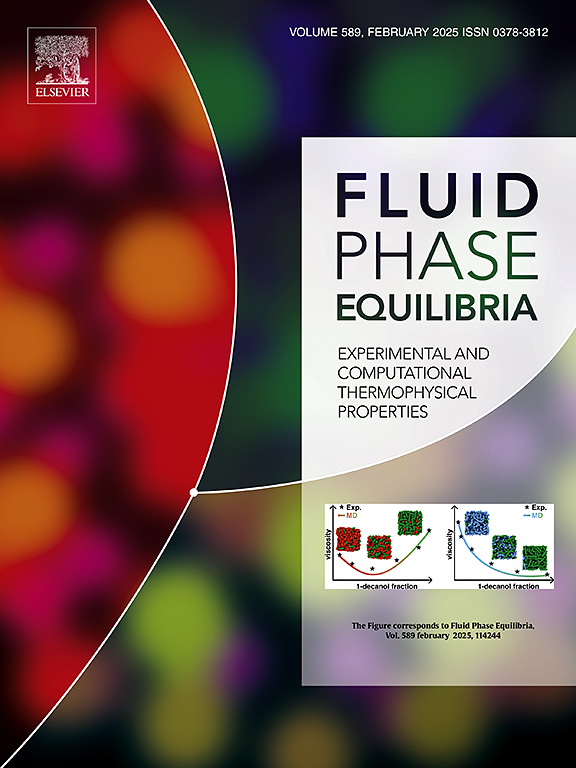3,4-二氟硝基苯和2,5-二氟硝基苯的热物理性质和等压气液平衡
IF 2.8
3区 工程技术
Q3 CHEMISTRY, PHYSICAL
引用次数: 0
摘要
3,4-二氟硝基苯和2,5-二氟硝基苯是重要的精细化工中间体,广泛应用于医药、农药、液晶材料等领域,特别是医药生产。关于它们的热力学性质的文献很少。对纯3,4-二氟硝基苯和2,5-二氟硝基苯液体进行了与温度相关的热物理性质测量:密度(293.15至353.15)K,粘度(293.15至353.15)K,饱和蒸汽压(366至478)K。在101.2 kPa下实验测定了3,4-二氟硝基苯和2,5-二氟硝基苯二元体系的等压汽液平衡(VLE)数据。利用DIPPR方程成功地模拟了密度与温度的对应关系。同时,选取4个方程对粘度数据进行分析,其中VFT方程得到的结果最为精确。此外,饱和蒸汽压与温度之间的关系可以用Antoine和Riedel方程精确地建立。二元VLE数据采用NRTL和Wilson方程建模,得到二元相互作用参数。这些参数推导的预测与实验结果密切相关,揭示了二元体系中不存在共沸行为。这些纯组分的热物理性质以及所提供的VLE数据对3,4-二氟硝基苯和2,5-二氟硝基苯的分离过程具有重要意义。本文章由计算机程序翻译,如有差异,请以英文原文为准。
Thermophysical properties and isobaric vapor-liquid equilibria for 3,4-difluoronitrobenzene and 2,5-difluoronitrobenzene
3,4-Difluoronitrobenzene and 2,5-difluoronitrobenzene are significant fine chemical intermediates, widely applied in the fields of medicine, pesticides, and liquid crystal materials, particularly in pharmaceutical production. The available literature on their thermodynamic properties is scarce. Thermophysical property measurements for pure 3,4-difluoronitrobenzene and 2,5-difluoronitrobenzene liquids were performed in relation to temperature: density (293.15 to 353.15) K, viscosity (293.15 to 353.15) K, saturated vapor pressure (366 to 478) K. Isobaric vapor-liquid equilibria (VLE) data for the 3,4-difluoronitrobenzene and 2,5-difluoronitrobenzene binary system were experimentally determined at 101.2 kPa. The correspondence between density and temperature was successfully modeled utilizing the DIPPR equation. Meanwhile, viscosity data were analyzed using four selected equations, with VFT equation yielding the most precise results. Furthermore, the correlation between saturated vapor pressure and temperature can be precisely established using Antoine and Riedel equations. The binary VLE data were modeled using NRTL and Wilson equations, yielding binary interaction parameters. These parameter-derived predictions closely aligned with experimental findings, revealing the absence of azeotropic behavior in the binary system. The thermophysical properties of these pure components, along with VLE data provided, are significant for the separation process of 3,4-difluoronitrobenzene and 2,5-difluoronitrobenzene.
求助全文
通过发布文献求助,成功后即可免费获取论文全文。
去求助
来源期刊

Fluid Phase Equilibria
工程技术-工程:化工
CiteScore
5.30
自引率
15.40%
发文量
223
审稿时长
53 days
期刊介绍:
Fluid Phase Equilibria publishes high-quality papers dealing with experimental, theoretical, and applied research related to equilibrium and transport properties of fluids, solids, and interfaces. Subjects of interest include physical/phase and chemical equilibria; equilibrium and nonequilibrium thermophysical properties; fundamental thermodynamic relations; and stability. The systems central to the journal include pure substances and mixtures of organic and inorganic materials, including polymers, biochemicals, and surfactants with sufficient characterization of composition and purity for the results to be reproduced. Alloys are of interest only when thermodynamic studies are included, purely material studies will not be considered. In all cases, authors are expected to provide physical or chemical interpretations of the results.
Experimental research can include measurements under all conditions of temperature, pressure, and composition, including critical and supercritical. Measurements are to be associated with systems and conditions of fundamental or applied interest, and may not be only a collection of routine data, such as physical property or solubility measurements at limited pressures and temperatures close to ambient, or surfactant studies focussed strictly on micellisation or micelle structure. Papers reporting common data must be accompanied by new physical insights and/or contemporary or new theory or techniques.
 求助内容:
求助内容: 应助结果提醒方式:
应助结果提醒方式:


